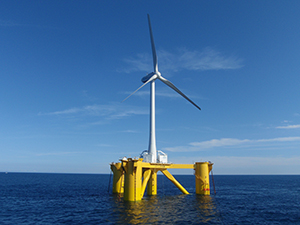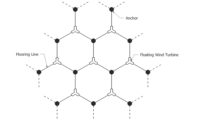
A Japanese demonstration project is the largest yet examining the feasibility of placing floating wind farms in deep water.
A government-backed consortium is building three floating platforms, each of a different design, 12 miles off Japan's Pacific shore, using two types of wind turbines with a total generating capacity of 16 megawatts.
The first, a 2-MW turbine and a floating substation, began operating in November. Two more 7-MW turbines will be brought online within 2015. The performance and durability of the platforms and turbines, the power output and the impact on the environment and fisheries will all be carefully monitored during operations expected to continue through March 2018.
"If this turns out to be successful, we will construct more wind farms of this type, but we also need to improve the cost performance," says Tetsuro Hori, general manager of new energy engineering for Shimizu Corp., which is handling construction aspects of the project for an 11-member group of trading companies, shipbuilders and heavy-equipment makers. Japan's Ministry of Economy, Trade and Industry is funding the $215-million project as part of efforts to help the country's Tohoku region recover from the 2011 earthquake, tsunami and nuclear disasters.
Hori says the platforms are based on established offshore oil-rig technologies. The first is triangular in plan with three columns rising from subsurface ballast chambers plus a center column supporting the turbine tower. The platform is 105 ft tall, the turbine hub is 213 ft above sea level, and each of the blades is 131 ft long. Hitachi Ltd. supplied the 2-MW turbine. Fabrication started in October 2012 in a Tokyo Bay dry dock. The completed platform was then tugged 200 miles to the site, which is at the edge of the exclusion zone surrounding the Fukushima Daiichi Nuclear Power Plant.
The project's first phase includes a spar-type floating substation supporting a transformer that will collect power from all three turbines and then transmit it to shore via a 66-kilovolt cable. The team claims this is the first floating transformer system serving a wind farm. Both platforms are moored by 32-ton bridles—six for the turbine and four for the substation—designed to dig into the sea floor when pulled.
Hori says one of the construction challenges was mooring the platforms during constant swells and turbulence. "There are virtually no calm periods at all," he says.
Of the two remaining platforms, one will be V-shaped in plan, and the other will be a spar with a single tower rising from submerged ballast chambers. Both will support 7-MW hydraulic-drive turbines from Mitsubishi Heavy Industries. In promotional materials, the company claims the hydraulic drive train is more efficient than conventional geared systems.
Data on how he platforms respond to winds, waves and currents will be compared with the results of water-tank tests and computer modeling so engineers can fine-tune future designs.
The Fukushima wind farm is one of just a handful of prototype floating systems that have been tested. Blue H Technologies of the Netherlands operated an 80-KW floating turbine off the southern coast of Italy in 2008. Norway's Statoil has been operating a pilot 2.3-MW floating turbine in the North Sea since 2010. Principle Power, Seattle, has a 2-MW turbine in operation off the coast of Portugal. All three groups are studying additional installations.
For the Japanese system, "Bringing the cost down is a big issue," Shimizu's Hori says.
Takeo Kikkawa, an energy industry economist at Hitotsubashi University in Tokyo, says that reducing wind farm costs is just one piece of the puzzle. "I think [access to] transmission lines will be the bottleneck," Kikkawa says.



Post a comment to this article
Report Abusive Comment